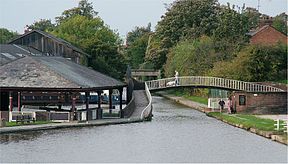Chester Canal
| Chester Canal | |
|---|---|

Chester Canal basin, on the Wirral Line of the Ellesmere Canal, at Raymond Street, near the junction with the Chester Canal and the River Dee
|
|
| Specifications | |
| Maximum boat length | 72 ft 0 in (21.95 m) (originally 80 ft 0 in or 24.38 m) |
| Maximum boat beam | 9 ft 0 in (2.74 m) (originally 14 ft 9 in or 4.50 m) |
| Locks | 14 |
| Status | Navigable |
| Navigation authority | Canal & River Trust |
| History | |
| Original owner | Chester Canal Company |
| Date of act | 1772 |
| Date of first use | 1779 |
| Geography | |
| Start point | Nantwich |
| End point | Chester |
| Branch of | Now part of Shropshire Union |
The Chester Canal was an English canal linking the south Cheshire town of Nantwich with the River Dee at Chester. It was intended to link Chester to Middlewich, with a branch to Nantwich, but the Trent and Mersey Canal were unco-operative about a junction at Middlewich, and so the route to Nantwich was opened in 1779. There were also difficulties negotiating with the River Dee Company, and with no possibility of through traffic, the canal was uneconomic. Part of it was closed in 1787, when Beeston staircase locks collapsed, and there was no money to fund repairs. When the Ellesmere Canal was proposed in 1790, the company saw it as a ray of hope, and somehow managed to keep the struggling canal open. The Ellesmere Canal provided a link to the River Mersey at Ellesmere Port from 1797, and the fortunes of the Chester Canal began to improve.
The Ellesmere Canal was also building branches in North Wales, which were intended to link up to the River Dee at Chester, but eventually linked to the Chester Canal at Hurleston Junction, just to the north of Nantwich, in 1805. The canal then became the middle section of a much longer and more profitable canal. The two companies merged in 1813, becoming the Ellesmere and Chester Canal. When the Birmingham and Liverpool Junction Canal was proposed in 1826, which would provide a link from Nantwich to Wolverhampton and the Birmingham canal system, the company saw it as an opportunity to build the Middlewich Branch, which would provide a connection to Manchester and the Potteries. The branch opened in 1833, and the Junction Canal opened in 1835. Amalgamation followed in 1845, with the new company retaining the name of the Ellesmere and Chester Canal. The following year, the Shropshire Union Railways and Canal Company was formed from the Ellesmere and Chester company, which also took over a number of canals which joined theirs. Plans to convert some of the canals to railways were put on hold in the 1847, when the canal company was leased to the London and North Western Railway. Under railway control, the canals continued to operate successfully, but decline set in during the 20th century, and when many of the adjoining canals were closed in 1944, the sections which had been the Ellesmere and Chester Canal and the Birmingham and Liverpool Junction Canal, together with the Middlewich Branch, were retained.
...
Wikipedia
